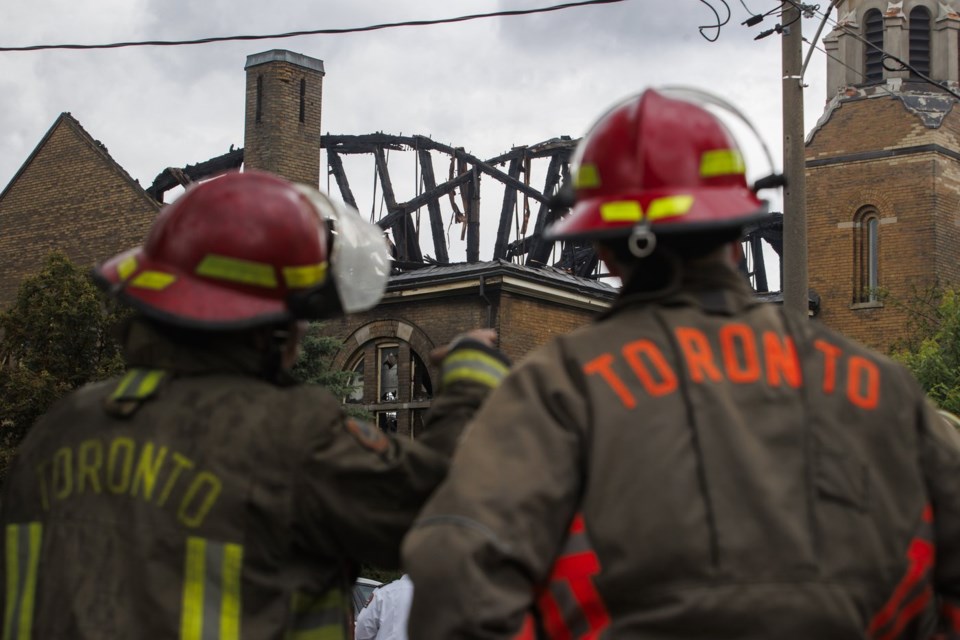TORONTO — As investigators work to determine the cause of a devastating fire at a historic Toronto church, community members and art experts are mourning the loss of a sacred space that housed unique artwork by members of the Group of Seven.
The Sunday morning blaze caused massive damage at St. Anne's Anglican Church, a national historic site where "extraordinary" early paintings by three Group of Seven members and other prominent Canadian artists were installed along the interior in the 1920s.
The murals decorated the chancel and the dome, which was destroyed in the blaze. No one was inside the church at the time.
“To be honest, it's heart-wrenching to come up here to see the church like this," St. Anne's rector Father Don Beyers said in an interview near the building Monday as the smell of ashes lingered in the air.
"I almost felt sick to my stomach to see it," he said, adding that church members are "incredibly hurt and sad."
The distinctive central dome of the Byzantine-style church built in the early 1900s is now gone, its interior appears to be gutted, and the brick walls are damaged but still standing. A few members of the church staff, accompanied by firefighters, were seen carrying documents out of the building on Monday.
Toronto police said the fire is not being treated as suspicious at this time, although investigators are still trying to pinpoint the cause.
The Office of the Fire Marshal said Monday it's too early to make any conclusions.
"The timeline of this investigation, like any others that we carry out, is fluid and will take as long as necessary to conclusively determine how the fire was started," spokesperson Sean Driscoll said in an email.
Beyers said the community has not only lost a place of worship, rites and holiday celebrations – it has also lost "Canadian artwork at its very best."
In 1923, the church commissioned J.E.H. MacDonald to oversee designs depicting the life of Christ on the building's interior. MacDonald then signed on nine other artists, including Franklin Carmichael and Frederick Varley.
MacDonald, Carmichael and Varley formed part of the school of landscape painters famously known as the Group of Seven.
"It's almost hard to describe how beautiful the works were and how rare. It was the only religious artwork to my knowledge that the Group of Seven ever did," Beyers said, noting that the murals depicted important Biblical scenes and prophets.
Those images of the prophets particularly showcased Varley's skills as a portrait painter, in addition to his landscape artistry, said Rob Cowley, president of Toronto-based art auctioneers Cowley Abbott.
It would be "impossible" to assign a monetary value to the destroyed murals, Cowley said in an interview.
"So much of their value really was the space where they were and their historical importance," he said. "Their importance in the marketplace would be impossible to say only because they do differ from what the Group of Seven were most celebrated for, which were depictions of the Canadian landscape."
Sarah Bassnett, an art history professor at Western University, said the lost murals were part of an early 20th-century movement to integrate paintings into architecture. The movement was interrupted by the First World War but revived to some extent in the 1920s, she said.
"It's part of this kind of move against mass production and an appreciation for the unique and the beautiful and the handcrafted and ... that was incorporated into this particular church in Toronto," Bassnett said.
Peter Coffman, an architectural historian at Carleton University, called St. Anne's church "a gloriously renegade" building in a "eulogy" posted on Monday.
"It was beautiful, yes – exceptionally so. But it was also a rebel. It was Byzantine when Anglican churches were supposed to be Gothic. It was decorated by artists with no experience in liturgical art," Coffman wrote in a post on the university's website.
"By the time it was fully completed, it was certainly the oddest Anglican church in Toronto, and possibly in the country," he wrote, concluding that it will be "impossible" to reconstruct the building.
But Beyers, the priest at St. Anne's, said the church community is determined to rise from the ashes. It hopes to achieve that with donations and support from others.
"I know we're going to rise out of this," he said. "This isn't the end of us and we're not going to stop. We're going to continue."
This report by The Canadian Press was first published June 10, 2024.
Maan Alhmidi, Alex Goudge and Sonja Puzic, The Canadian Press

